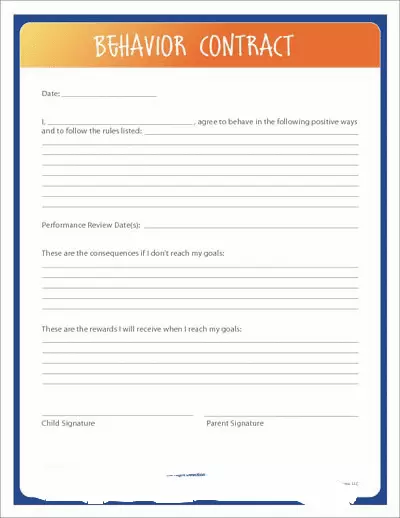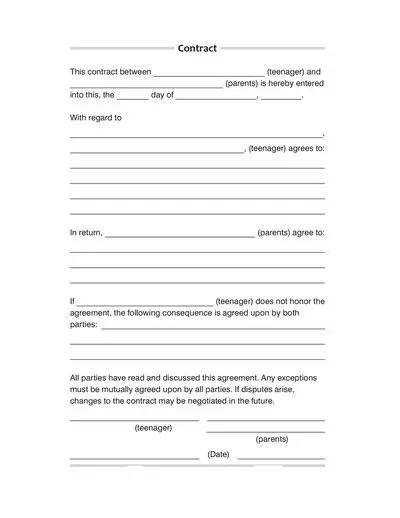BEHAVIOUR CONTRACTS.
Behaviour contracts for teenagers are a simple yet effective intervention to help modify behaviour(s).
A behaviour contract is a written agreement between two parties that captures:
- the commitment to achieve a measurable specific behaviour or task
- the consequences of the success or failure to accomplish the specified behaviour.
Behaviour contracts clearly outline the rules, expectations, and overall agreements that your child will adhere to in the school or home setting. It essentially helps improve challenging behaviours through a reward system, allowing children to understand the consequences of their actions, make good choices, and be more accountable. It is a great parenting tool and a helpful resource to address behaviours
Why are Teen Behaviour Contracts Effective?
Behaviour contracts are effective for a number of reasons:
- Behaviour contracts allow us to capture in a clear and concise way behaviour expectations, making it easier for children to understand and accomplish them.
- Behaviour contracts act as a behavioural prompt, at two levels:
- The contract specifies a rule that is followed by a consequence. So one of the mechanisms that may explain why contingency agreements work is that what the child or teen does becomes a “rule-governed behaviour“
- Physically displaying the contract may act as a reminder of the expected behaviour
- A behaviour contract is a public commitment. Research suggests that when we make our goals public, we are more likely to stick to them.
- A contract is a collaborative approach to behaviour management. Your teen should be involved when crafting the agreement, and as a consequence, they are more likely to buy in to the expected behavioural changes
- Contracts are flexible tools that can be adjusted and/or revised as needed.
- These contracts also assist parents/adults to stay focused on the desired behaviours and outcomes
- Contracts may sometimes carry over from the home setting to the school setting, thereby improving communication between both parties. For example, hitting is not acceptable behaviour at home or at school.
- Behaviour contracts promote independence
- Children are more likely to self-regulate and understand the consequences of their actions.
- They may assist teens to self-reflect and increase their desire to improve their behaviour.
Components of a Behaviour Contract
Behaviour contracts are generally formally written down and will have 3 main components:
- Behaviour / Task
- Consequence/ Reward
- Task or Behaviour Measurement
Defining the Task in a Behaviour Contract and Practical Examples
The first component is desired behaviour or task(s).
Within this component, we must address the common Ws questions (who, what, when, and how):
- What specific behaviours are you trying to address, diminish or improve?
- Who is committing the behaviour / completing the task?
- When is the behaviour happening?
- How do you want to see it improve/change?
Let’s take, for example, a relatively small challenging behaviour such as slamming doors.
If you are aiming to have this behaviour diminish, these would be the questions to address in your behaviour contract.
- What is the behaviour: Slamming doors
- Who is engaging in the behaviour: Your teenager
- When is the behaviour happening: When your teen is upset or overwhelmed
- How do you want to improve this behaviour: You would like your teenager to decrease the number of times they slam doors when upset, and instead go to their break corner.
Other important aspects to consider when you are choosing the behaviour you will include in your parent-child contract:
- It is important to choose a behaviour or task that can be objectively measured:
- a physical output: I will read 10 pages of my book every evening
- a behaviour that is witnessed and measured by somebody: no door slamming
Identifying the Consequence or Reward in a Teen Behaviour Contract
The next component is perhaps the most important because it identifies what the consequence of success or failure will be.
It is important that you involve your teen in this part of the process, as the reward will be a strong motivator to change the given behaviour.
We need to be clear and specific on the reward components too:
- What will be the reward?
- When will it happen?
- How long will it last?
- Who will deliver it?
- What will happen if the child or teen doesn’t complete the task or behaviour? (penalty clauses)
Ask your teen to write down on a piece of paper what potential rewards they would like to earn if they complete the task or desired behaviour. You can also have a brainstorming discussion.
The reward should be something that you, the parent, can give to your teen, as well as something that is proportionate to the behaviour.
You’re not going to give your teen a brand new car for not slamming the doors. Instead, it should be something simple. Maybe a pizza party, allowing for a sleepover at their best friend’s house, extending their curfew for a special concert. Whatever your child is motivated by, and whatever you are able to provide as the parent.
Measuring the Task / Behaviour
The final component that can not be ignored, is the measurement of when the behaviour has been achieved.
In some cases, it will be interesting to understand how often the behaviour is currently occurring. This baseline will allow us to set realistic and achievable objectives.
Let’s go back to the same door-slamming example. Is your teenager is engaging in this behaviour 10 times a day, every hour, or maybe even after every meal? It would benefit you and your teenager to make the goal attainable by stating that they don’t slam the door for one day, for one meal, or for a certain amount of time respectively. This way the goal is attainable and does not become too much of an overwhelming task
BEFORE RUNNING OFF TO DRAW UP YOUR CONTRACTS WITH YOUR TEEN. SIT DOWN AND THINK WHICH BEHAVIOURS YOU WISH TO ADDRESS. IT IS NOT APPROPRIATE TO ADDRESS ALL 101 FAULTS YOUR TEEN MAY HAVE. JUST FOCUS ON THE TWO MOST IMPORTANT. THE REST CAN WAIT

